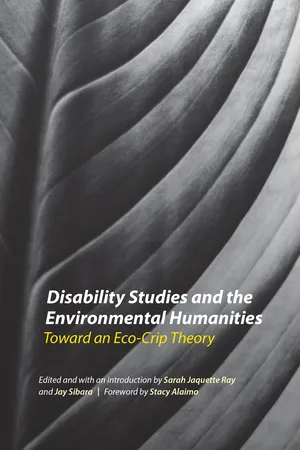
Disability Studies and the Environmental Humanities
Toward an Eco-Crip Theory
- 648 pages
- English
- ePUB (mobile friendly)
- Available on iOS & Android
Disability Studies and the Environmental Humanities
Toward an Eco-Crip Theory
About this book
Although scholars in the environmental humanities have been exploring the dichotomy between "wild" and "built" environmentsfor several years, few have focused on the field of disability studies, a discipline that enliststhe contingency between environments and bodies as a foundation of its scholarship. On the other hand, scholars in disability studieshave demonstrated the ways in which the built environment privileges some bodies and minds over others, yet theyhave rarelyexaminedthe ways in which toxic environments engenderchronic illness and disability or how environmental illnesses disrupt dominant paradigms for scrutinizing "disability." Designed as a reader for undergraduate and graduate courses, Disability Studies and the Environmental Humanities employs interdisciplinary perspectives to examine such issues as slow violence, imperialism, race, toxicity, eco-sickness, the body in environmental justice, ableism, and other topics. With a historical scope spanning the seventeenth century to the present, this collection not only presents the foundational documents informing this intersection of fields but also showcases the most current work, making it an indispensable reference.
Frequently asked questions
- Essential is ideal for learners and professionals who enjoy exploring a wide range of subjects. Access the Essential Library with 800,000+ trusted titles and best-sellers across business, personal growth, and the humanities. Includes unlimited reading time and Standard Read Aloud voice.
- Complete: Perfect for advanced learners and researchers needing full, unrestricted access. Unlock 1.4M+ books across hundreds of subjects, including academic and specialized titles. The Complete Plan also includes advanced features like Premium Read Aloud and Research Assistant.
Please note we cannot support devices running on iOS 13 and Android 7 or earlier. Learn more about using the app.
Information
Table of contents
- Cover
- Title Page
- Copyright Page
- Contents
- List of Illustrations
- Foreword
- Introduction
- Part 1. Foundations
- 1. Risking Bodies in the Wild
- 2. Bringing Together Feminist Disability Studies and Environmental Justice
- 3. Lead’s Racial Matters
- 4. Defining Eco-ability
- 5. The Ecosomatic Paradigm in Literature
- 6. Bodies of Nature
- 7. Notes on Natural Worlds, Disabled Bodies, and a Politics of Cure
- Part 2. New Essays
- Section 1: Corporeal Legacies of U.S. Nation-Building
- 8. Blind Indians
- 9. Prosthetic Ecologies
- 10. Reification, Biomedicine, and Bombs
- 11. War Contaminants and Environmental Justice
- Section 2: (Re)Producing Toxicity
- 12. Toxic Pregnancies
- 13. “That Night”
- Section 3: Food Justice
- 14. Disabling Justice?
- 15. Cripping Sustainability, Realizing Food Justice
- Section 4: Curing Crips?
- 16. The Invalid Sea
- 17. La Tierra Pica/The Soil Bites
- 18. Cripping East Los Angeles
- 19. Neurological Diversity and Environmental (In)Justice
- Section 5: Interspecies and Interage Identifications
- 20. Precarity and Cross-Species Identification
- 21. Autism and Environmental Identity
- 22. Moving Together Side by Side
- Source Acknowledgments
- Contributors
- Index
- About Sarah Jaquette Ray
- About Jay Sibara
- About Stacy Alaimo